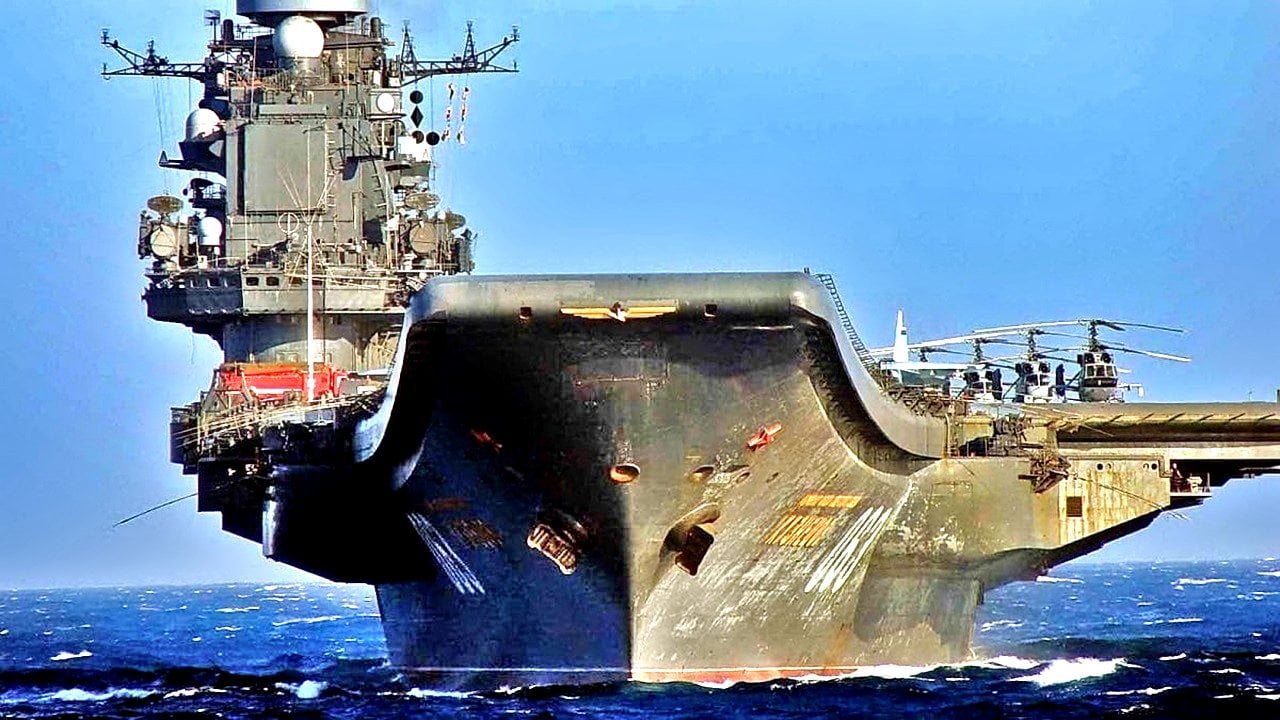Peter Suciu

The United States Navy has eleven aircraft carriers of the world's 40 plus active flattops that are operated by fourteen navies. Yet, it is important to remember that not all of those ships are in active service. Vessels can be officially commissioned and considered active in the navy rolls, yet, still be out of service as they undergo refits and repairs.
This is the case with the USS George Washington (CVN-73) and USS John C. Stennis (CVN-74), which are each currently undergoing their respective nuclear refueling and overhaul. This process typically takes four years as the ships are essentially taken apart and rebuilt.
Russia Has No Aircraft Carriers, Technically
It is thus a “trick question” when asking about the number of Russian aircraft carriers. If we're going to be completely "technical" on the matter, Admiral Flota Sovetskogo Soyuza Kuznetsov ("Admiral of the Fleet of the Soviet Union Kuznetsov") isn’t actually an aircraft carrier.
Instead it is a heavy aircraft cruiser in Russian classification.
History
The flagship of the Russian Navy, she was built by the Black Sea Shipyard and launched in 1985.
Originally named Riga, she was launched as the Leonid Brezhnev, embarked on sea trials as Tbilisi, but was finally named for Admiral Nikolay Gerasimovich Kuznetsov, a hero of the Soviet Union.
At the time of her commissioning, the Soviet Navy had intended her to be the lead ship of a class of at least two aircraft cruisers. However, her sister ship – Varyag – was incomplete when the Soviet Union broke up in 1991.
The unfinished warship was subsequently sold by Ukraine to China and eventually completed/refurbished in Dalian and commissioned as the Type 001 Liaoning.
Trick Question, Explained
To get into a little more detail, this trick question has a second component.
Admiral Kuznetsov is Moscow's sole carrier, but given the state of affairs in Russia, it is unlikely that there will be any future carriers. More importantly, it could be argued that Russia technically has no carriers as the flagship has been out of service for a refit in Murmansk since November 2018. It remains unclear when - or even if - she ever returns to service.
Problem Plagued Warship
Even before the carrier returned for her refit, some officials in the United States Navy had expressed concerns that the carrier was unfit for service. In 2011, the Navy was worried that she might sink while in service in the Mediterranean Sea as she struggled during her only fourth deployment from her northern base to reach Russia's naval facilities in Syria. That concern was reportedly so great that the United States Navy's Sixth Fleet was tasked with maintaining contact in case the carrier floundered.
Such fears were actually well-founded and justified, as just two years earlier, Admiral Kuznetsov suffered a fire at sea while deployed to the Mediterranean, resulting in the death of a sailor onboard. In addition, the flattop – which had notoriously and routinely belched black smoke into the air – spilled hundreds of tons of fuel into the sea while refueling.
That smoke was a regular problem and a serious environmental concern wherever she sailed.
Unlike western vessels that use gas turbines or nuclear power, the Russian flattop is fueled by mazut, which often results in a trail of heavy black smoke that can be seen from great distances. The smoke signal is hardly ideal as it practically announces the location of the carrier from miles away.
In addition, the Russian flagship has an endurance that is a mere 45 days. That issue is compounded by the fact that even before it began its war in Ukraine, Russia had few ports where the aircraft cruiser could operate year-round. During deployments, the carrier was often escorted with tugs in case she were to break down. In 2015, the aircraft cruiser even had to be towed back to port.
Worst of all, Admiral Kuznetsov relied on a bow ski ramp to launch fighters, even though Russian aircraft designs are ill-suited to the task.
The Never-Ending Refit for Russia's Sort of Aircraft Carrier
When Admiral Kuznetsov was in service, it could be argued she was barely a reliable warship However, she isn't in service and hasn’t been for years.
Since November 2018, she's been undergoing a refit that has proven especially troublesome. Soon after arriving in port, the carrier was damaged when a 70-ton floating crane fell on the flight deck, tragically killing a worker and injuring four more. Just a year later, a fire broke out in the engine room during a welding accident, which resulted in two more deaths.
The facility's drydock, which is absolutely vital to the repairs, was damaged during a power outage. Corruption has also been an issue, so much so that the director general of the shipyard overseeing the repairs was arrested for embezzlement of funds.

The original plan was to see the ship returned to service in 2020 and remain operational until the end of the decade. At this point, she is unlikely to begin post-refit sea trials until at least the end of 2024… at the very earliest. It isn't even clear if Admiral Kuznetsov will be able to return to service in time to be officially retired.
As for the answer to the question, "How many aircraft carriers does Russia really have?" The answer is none, but of course complicated by history and naval designations that are not exactly common.
No comments:
Post a Comment